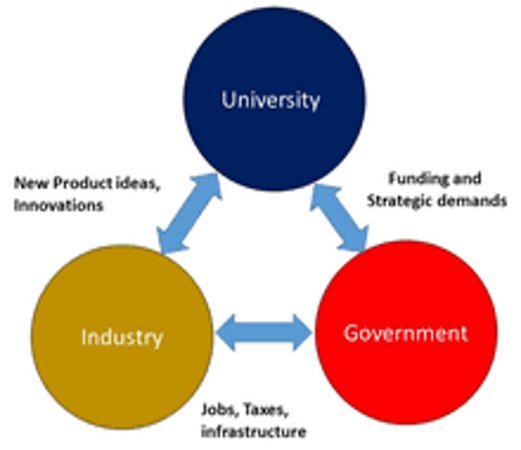What is a Cluster and Why do we need them?
Clusters are an umbrella concept. Variations in usage of the concept exist across countries and sectors, and between academics, industry and Government policy makers. Since cluster terminology can mean different things to different people, it’s important to start out by defining what we’re talking about when we refer to cluster terminology:
Michael Porter, who developed cluster theory in the 1990s, defines Clusters as “geographic concentrations of interconnected companies, specialised suppliers, service providers, firms in related industries, and associated institutions (for example universities, standards agencies, and trade associations) in particular fields that compete but also co-operate.”
A Cluster initiative (defined by Sölvell et al., 2003) is “an organised effort to increase the growth and competitiveness of a cluster within a region, involving cluster firms, government and/or the research community.”
Cluster initiatives are “managed by specialised institutions, known as Cluster organisations, which take various forms, ranging from non-profit associations, through public agencies to companies” (EC, 2008, p.8).
Perhaps one of the more famous clusters is Silicon Valley but today it is estimated that some 4,000 clusters exist across Europe. Industry clusters have been popular in Ireland over the last decade and more recently in 2019/2020 when Enterprise Ireland funded twelve clusters on the Island under the Regional Technology Cluster Fund (RTCF). Killybegs Marine Cluster is one of twelve clusters on the Island and part of Enterprise Ireland’s national clustering programme and the one dedicated Blue Economy Marine Cluster.
A Cluster Manager manages “the organisation and coordination of the activities of a cluster in accordance with a certain strategy, in order to achieve clearly defined objectives” (PWC, 2011, p8). Cluster Management goes beyond management of an individual organisation. It implies mediating and facilitating the relationships of multiple organisations, i.e., cluster members. Each of the cluster members has its own agenda, and a key challenge for cluster managers is to make sure those agendas are united into common objectives and collective actions, that conflicting interests are resolved, and the relevant organisations see enough added value to justify their participation in cluster activities.
This ecosystem can be broken down into the three key pillars of the Triple Helix: Industry, Academia, Government.
- Industry – core and support firms, from start-ups and SMEs to multinationals, including business organisations.
- Academia – universities, further education and training bodies, and public research centres.

- Government & public agencies – Government departments, state agencies, regional authorities, local authorities, non-governmental organisations and philanthropic stakeholders.
With the input of Citizens, or society, forming the fourth pillar of the quadruple-helix. A practical difficulty in cluster development is the differing rationales for engagement between these actors. The challenge for the cluster is to combine the strengths of the ecosystem to develop synergies between all stakeholders to maximise the outputs and optimise the cluster.
What is NOT a cluster (organisaton)?
It is equally as important to know what a cluster is not, as the term ‘cluster’ has become increasingly popular and overly used in economic development. When public support is available, many activities are quickly dressed up as ‘clusters’ to target funding. So what is NOT a Cluster?
- Land or property development such as an industrial park or science parks, e.g. IDA Technology Parks
- Start-up or innovation supports, such as business incubators e.g. the Guinness Enterprise Centre
- A special economic zone or free trade zone e.g. Shannon Free Zone;
- An industry, a trade or a professional association;
- A supply chain, an export network, or other business co-operatives;
- A large MNC with suppliers or customers.
However, it is important to note that each of these may well be an important element within a cluster.
Why Support Clusters?
Research on industry clusters has found that they affect competition in three ways:
- increasing the productivity of cluster firms,
- increasing the innovation capacity of firms, and
- stimulating new business formation.
- Clusters are a major part of the European industrial landscape. There are around 3,000 specialised clusters in Europe, which account for in excess of 54 million jobs. Clusters nurture growth and provide additional jobs, with wages in strong clusters close to 3% higher when compared to non-clustered firms. Many clusters focus on supporting and integrating SMEs to connect, scale, innovate and internationalise. Clusters are represented in all parts of Europe and have shown resilience during previous economic crises and also in a cross collaboration role, where they have been seen to support the emergence of new clusters in new industrial areas(bringing innovation and manufacturing techniques to different regions and economies). Additionally, strong clusters have been shown to be particularly successful in attracting new investment and talent into specific regions. This demonstrates the critical role clusters can play for Ireland in the recovery from COVID-19, and in face of balanced regional economic development across the island.
- Now that we have an understanding of what is, and what is not, a cluster and the impacts clusters have had across Europe, we can next look at how to identify when a clustering initiative is a suitable economic development support in Step 1: Identifying the Need: Challenges of Industry.